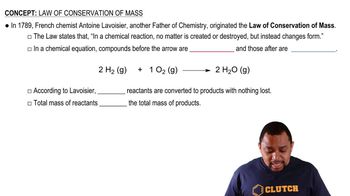Methanol (CH3OH) has been suggested as a fuel to replace gasoline. Find ΔH°rxn, and determine the mass of carbon dioxide emitted per kJ of heat produced. Use the information from the previous exercise to calculate the same quantity for octane, C8H18. How does methanol compare to octane with respect to global warming?
Ch.6 - Thermochemistry
Chapter 6, Problem 97b
The kinetic energy of a rolling billiard ball is given by KE = 1/2 mv2. Suppose a 0.17-kg billiard ball is rolling down a pool table with an initial speed of 4.5 m/s. As it travels, it loses some of its energy as heat. The ball slows down to 3.8 m/s and then collides head-on with a second billiard ball of equal mass. The first billiard ball completely stops and the second one rolls away with a velocity of 3.8 m/s. Assume the first billiard ball is the system. Calculate q.

Verified Solution
Video duration:
4mWas this helpful?
Key Concepts
Here are the essential concepts you must grasp in order to answer the question correctly.
Kinetic Energy
Kinetic energy (KE) is the energy an object possesses due to its motion, calculated using the formula KE = 1/2 mv², where m is the mass and v is the velocity of the object. In this scenario, the billiard ball's kinetic energy changes as it slows down and eventually transfers its energy during a collision.
Recommended video:
Guided course

Kinetic & Potential Energy
Conservation of Momentum
The principle of conservation of momentum states that in a closed system, the total momentum before an event must equal the total momentum after the event. In this case, the momentum of the first billiard ball is transferred to the second ball during the collision, allowing us to analyze the system's behavior before and after the impact.
Recommended video:
Guided course

Law of Conservation of Mass
Heat Transfer (q)
Heat transfer, denoted as q, refers to the energy that is transferred from one system to another due to a temperature difference. In this problem, as the first billiard ball slows down, some of its kinetic energy is converted into heat, which can be quantified to understand the energy lost during its motion.
Recommended video:
Guided course

Heat Capacity
Related Practice
Textbook Question
1191
views
Open Question
The citizens of the world burn the fossil fuel equivalent of 7 * 10^12 kg of petroleum per year. Assume that all of this petroleum is in the form of octane (C8H18) and calculate how much CO2 (in kg) the world produces from fossil fuel combustion per year. (Hint: Begin by writing a balanced equation for the combustion of octane.) If the atmosphere currently contains approximately 3 * 10^15 kg of CO2, how long will it take for the world’s fossil fuel combustion to double the amount of atmospheric carbon dioxide?
Textbook Question
In a sunny location, sunlight has a power density of about 1 kW/m2. Photovoltaic solar cells can convert this power into electricity with 15% efficiency. If a typical home uses 385 kWh of electricity per month, how many square meters of solar cells are required to meet its energy requirements? Assume that electricity can be generated from the sunlight for 8 hours per day.
685
views
Open Question
A 100-W lightbulb is placed in a cylinder equipped with a moveable piston. The lightbulb is turned on for 0.015 hour, and the assembly expands from an initial volume of 0.85 L to a final volume of 5.88 L against an external pressure of 1.0 atm. Use the wattage of the lightbulb and the time it is on to calculate ΔE in joules (assume that the cylinder and lightbulb assembly is the system and assume two significant figures). Calculate w. Calculate q.
Open Question
Evaporating sweat cools the body because evaporation is an endothermic process: H2O(l) → H2O(g) ΔH°rxn = +44.01 kJ. Estimate the mass of water that must evaporate from the skin to cool the body by 0.50°C. Assume a body mass of 95 kg and assume that the specific heat capacity of the body is 4.0 J/g°C.
Textbook Question
LP gas burns according to the exothermic reaction: C3H8(g) + 5 O2(g) → 3 CO2(g) + 4 H2O(g) ΔH°rxn = –2044 kJ What mass of LP gas is necessary to heat 1.5 L of water from room temperature (25.0 °C) to boiling (100.0 °C)? Assume that during heating, 15% of the heat emitted by the LP gas combustion goes to heat the water. The rest is lost as heat to the surroundings.
2175
views
1
rank
